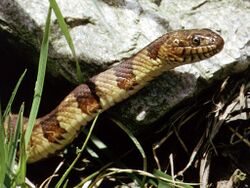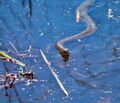Biology:Northern water snake
| Northern water snake | |
|---|---|

| |
| Nerodia sipedon | |
| Scientific classification | |
| Domain: | Eukaryota |
| Kingdom: | Animalia |
| Phylum: | Chordata |
| Class: | Reptilia |
| Order: | Squamata |
| Suborder: | Serpentes |
| Family: | Colubridae |
| Genus: | Nerodia |
| Species: | N. sipedon
|
| Binomial name | |
| Nerodia sipedon | |
| Subspecies | |
|
Four, see text | |
| Synonyms[2][3] | |
| |
The northern water snake (Nerodia sipedon) is a species of large, nonvenomous, common snake in the family Colubridae. The species is native to North America.
Common names
Common names for Nerodia sipedon include banded water snake, black water adder, black water snake, brown water snake, common water snake, common northern water snake, eastern water snake, North American water snake, northern banded water snake, northern water snake, spotted water snake, streaked snake, water pilot and water snake.[4]
Description
The northern water snake can grow up to 135 cm (4 ft 5 in) in total length (including tail).[5] Per one study, average total length of females was 81.4 cm (2 ft 8 in) while that of males was 69.6 cm (2 ft 3 in).[6] Per known studies of this species in the wild, adult females can weigh between 158.9 and 408 g (5.61 and 14.39 oz) in average body mass while the smaller male can average from 80.8 to 151 g (2.85 to 5.33 oz).[7][8][9][10] The largest females can weigh up to 560 g (20 oz) while the largest males can scale 370 g (13 oz).[11][12]
Nerodia sipedon can be brown, gray, reddish, or brownish-black. It has dark crossbands on the neck and dark blotches on the rest of the body, often leading to misidentification as a cottonmouth or copperhead by novices. As N. sipedon ages, the color darkens, and the pattern becomes obscure. Some individuals will become almost completely black. The belly also varies in color. It can be white, yellow, or gray. Usually it also has reddish or black crescents.
The northern water snake is nonvenomous and harmless to humans, but superficially resembles the venomous cottonmouth and is often killed unnecessarily as a result of this mistaken identity. The two can be easily distinguished by morphological traits: the water snake has a longer, more slender body and a flattened head the same width as the neck, round pupils, and no heat-sensing pits. The cottonmouth has a fatter body, a wedge-shaped head with prominent venom glands that are wider than the neck, cat-like pupils, and heat-sensing pits between the eyes and the nostrils.[13]
Colubrid snakes also have flat scales upon their heads, while vipers all possess smaller, rugose scutes.
Subspecies
The following four subspecies are recognized as being valid (listed alphabetically).[2]
- Nerodia sipedon insularum (Conant & Clay, 1937) – Lake Erie water snake
- Nerodia sipedon pleuralis (Cope, 1892) – midland water snake
- Nerodia sipedon sipedon (Linnaeus, 1758) – northern water snake
- Nerodia sipedon williamengelsi (Conant & Lazell, 1973) – Carolina water snake
Geographic range
The northern water snake is found throughout eastern and central North America, from southern Ontario and southern Quebec in the north, to Texas and Florida in the south.[14] It has been introduced in California where it is considered an invasive species likely to compete with native giant garter snakes Thamnophis gigas.[15]
Behavior
N. sipedon is active during the day and at night. It is most often seen basking on rocks, stumps, or brush. During the day, it hunts among plants at the water's edge, looking for small fish, frogs, worms, leeches, crayfish, salamanders, small birds and mammals [citation needed]. At night, it concentrates on minnows and other small fish sleeping in shallow water. It hunts using smell and sight. The Lake Erie water snake subspecies, Nerodia sipedon insularum, was once endangered, but now benefits from the introduction of the round goby, an invasive species, which now constitutes up to 90% of its diet.
The northern water snake is common over most of its range and is frequently seen basking on stream banks, from which it dives into the water at the slightest disturbance. It is quick to flee from danger, but if cornered or captured, it usually will not hesitate to defend itself. Larger specimens can inflict a painful bite.
Reproduction
The northern water snake mates from April through June. It is ovoviviparous (live-bearing), which means it does not lay eggs like many other snakes. Instead, the mother carries the eggs inside her body and gives birth to free living young, each one 19–23 cm (7.5–9.1 in) long.[16] A female may have as many as thirty young at a time, but the average is eight. They are born between August and October. Mothers do not care for their young; as soon as they are born, they are on their own.
Defense against predators
Nerodia sipedon has many predators, including birds, raccoons, opossums, foxes, snapping turtles, other snakes, and humans. The northern water snake defends itself vigorously when threatened. If picked up by an animal, or person, it will bite repeatedly, as well as release excrement and musk. Its saliva contains a mild anticoagulant, which can cause the bite to bleed more but poses little risk to humans.
Habitats
Muskrat houses and beaver lodges are good places to find the northern water snake, which likes to hide among the sticks and plant stems. N. sipedon lives near lakes, ponds, marshes, rivers, and canals; just about anywhere there is freshwater.[citation needed]
Conservation status
The Lake Erie water snake subspecies (Nerodia sipedon insularum), which occurs mainly on the lake's western islands offshore from Ohio and Ontario, recovered to the point where on August 16, 2011 the U.S. Fish and Wildlife Service removed it from the Federal List of Endangered and Threatened Wildlife. The subspecies was first listed as threatened in 1999 after a decline due to eradication by humans, as well as habitat loss and degradation. When initially listed, the subspecies’ population had dropped to only 1,500 adults. Endangered Species Act (ESA) protections for the snake included designation of 300 acres (121 hectares) of inland habitat and 11 miles (18 km) of shoreline for breeding grounds. The introduction of an invasive species, the Eurasian round goby (Neogobius melanostomus) into Lake Erie in the mid-1990s became a new food source for the Lake Erie water snake. By 2009, the population recovered to 11,980 snakes, safely exceeding the population minimum goal of 5,555 adult snakes required by the 2003 recovery plan. Monitoring will occur for 5 years following this delisting. The Lake Erie water snake is just the 23rd species or subspecies to be removed from the list due to recovery.[17]
Gallery
References
- ↑ Hammerson GA (2007). "Nerodia sipedon ". IUCN Red List of Threatened Species 2007: e.T62239A12583567. doi:10.2305/IUCN.UK.2007.RLTS.T62239A12583567.en. https://www.iucnredlist.org/species/62239/12583567.
- ↑ 2.0 2.1 Nerodia sipedon . The Reptile Database. www.reptiledatabase.org.
- ↑ Stejneger L, Barbour T (1917). A Check List of North American Amphibians and Reptiles. Cambridge, Massachusetts: Harvard University Press. 125 pp. (Natrix sipedon, p. 96).
- ↑ Wright AH, Wright AA (1957).
- ↑ Northern water snake, Canadian Biodiversity.
- ↑ Weatherhead, Patrick J.; Barry, Frances E.; Brown, Gregory P.; Forbes, Mark R. L. (1995). "Sex ratios, mating behavior and sexual size dimorphism of the common water snake, Nerodia sipedon ". Behavioral Ecology and Sociobiology 36 (5): 301–311. doi:10.1007/BF00167791.
- ↑ Jellen, Benjamin C.; Aldridge, Robert D. (2014). "It takes two to tango: Female movement facilitates male mate location in wild common water snakes (Nerodia sipedon)". Behaviour 151 (4): 421–434. doi:10.1163/1568539X-00003128.
- ↑ Brown, Gregory P.; Weatherhead, Patrick J. (2000). "Thermal Ecology and Sexual Size Dimorphism in Northern Water Snakes, Nerodia sipedon ". Ecological Monographs 70 (2): 311–330. doi:10.1890/0012-9615(2000)070[0311:TEASSD2.0.CO;2].
- ↑ Schulte-Hostedde AI, Montgomerie R (2006). "Intraspecific variation in ejaculate traits of the northern watersnake (Nerodia sipedon)". Journal of Zoology 270 (1): 147–152. doi:10.1111/j.1469-7998.2006.00101.x.
- ↑ Brown, Gregory P.; Weatherhead, Patrick J. (1999). "Demography and sexual size dimorphism in northern water snakes, Nerodia sipedon ". Canadian Journal of Zoology 77 (9): 1358–1366. doi:10.1139/z99-112.
- ↑ Weatherhead, Patrick J.; Brown, Gregory P. (1996). "Measurement versus estimation of condition in snakes". Canadian Journal of Zoology 74 (9): 1617–1621. doi:10.1139/z96-179.
- ↑ King RB (2002). "Predicted and observed maximum prey size - snake size allometry". Functional Ecology 16 (6): 766–772. doi:10.1046/j.1365-2435.2002.00678.x.
- ↑ http://ufwildlife.ifas.ufl.edu/water_moccasin_watersnake_comparison.shtml[full citation needed]
- ↑ Schmidt KP, Davis DD (1941). Field Book of Snakes of the United States and Canada. New York: G.P. Putnam's Sons. 365 pp. (Natrix sipedon, pp. 219-222, Figure 22 (map) + Plate 24 on p. 344).
- ↑ Rose, Jonathan P.; Miano, Oliver J.; Todd, Brian D. (2013). "Trapping Efficiency, Demography, and Density of an Introduced population of Northern Watersnakes, Nerodia sipedon, in California". Journal of Herpetology 47 (3): 421–427. doi:10.1670/12-119. https://escholarship.org/content/qt0kp023wd/qt0kp023wd.pdf?t=o2fguc.
- ↑ Conant R (1975). A Field Guide to Reptiles and Amphibians of Eastern and Central North America, Second Edition. Boston: Houghton Mifflin. xviii + 429 pp. ISBN:0-395-19979-4 (hardcover), ISBN:0-395-19977-8 (paperback). (Natrix sipedon, pp. 144-146 + Plate 20 + Map 99).
- ↑ Endangered and Threatened Wildlife and Plants; Removal of the Lake Erie water snake (Nerodia sipedon insularum) From the Federal List of Endangered and Threatened Wildlife (Report). 2011-08-16. http://www.gpo.gov/fdsys/pkg/FR-2011-08-16/pdf/2011-20104.pdf. Retrieved 2011-09-03.
Further reading
- Conant R, Bridges W (1939). What Snake Is That? A Field Guide to the Snakes of the United States East of the Rocky Mountains. (With 108 drawings by Edmond Malnate). New York and London: D. Appleton-Century. Frontispiece map + viii + 163 pp. + Plates A-C, 1-32. (Natrix sipedon sipedon, pp. 98–101 + Plate 18, Figure 51).
- Holbrook JE (1842). North American Herpetology; or, A Description of the Reptiles Inhabiting the United States. Vol. IV. Philadelphia: J. Dobson. 138 pp. + Plates I-XXXV. (Tropidonotus sipedon, pp. 29–31 + Plate VI).
- Linnaeus C (1758). Systema naturæ per regna tria naturæ, secundum classes, ordines, genera, species, cum characteribus, diferentiis, synonymis, locis. Tomus I. Editio Decima, Reformata. Stockholm: L. Salvius. 824 pp. (Coluber sipedon, new species, p. 219). (in Latin).
- Morris PA (1942). Boy's Book of Snakes: How to Recognize and Understand Them. A volume of the Humanizing Science Series edited by Jacques Cattell. New York: Ronald Press. viii + 185 pp. (Natrix sipedon, pp. 78–81, 180).
- Powell R, Conant R, Collins JT (2016). Peterson Field Guide to Reptiles and Amphibians of Eastern and Central North America, Fourth Edition. Boston and New York: Houghton Mifflin Harcourt. xiv + 494 pp. ISBN:978-0-544-12997-9. (Nerodia sipedon, pp. 420–421 + Plate 41 + photo on p. xiv).
- Smith HM, Brodie ED Jr (1982). Reptiles of North America: A Guide to Field Identification. New York: Golden Press. 240 pp. ISBN:0-307-13666-3 (paperback). (Nerodia sipedon, pp. 156–157).
- Wright AH, Wright AA (1957). Handbook of Snakes of the United States and Canada. Ithaca and London: Comstock Publishing Associates, A Division of Cornell University Press. 1,105 pp. (in 2 volumes) (Natrix sipedon, pp. 510–544, Figures 150-161, Map 42).
- Zim HS, Smith HM (1956). Reptiles and Amphibians: A Guide to Familiar American Species: A Golden Nature Guide. New York: Simon and Schuster. 160 pp. (Natrix sipedon, pp. 102–103, 156).
External links
- Northern Water Snake, Davidson College
- Northern Water Snake, Reptiles and Amphibians of Iowa
- Information about Northern Water Snake control
Wikidata ☰ Q2163958 entry














